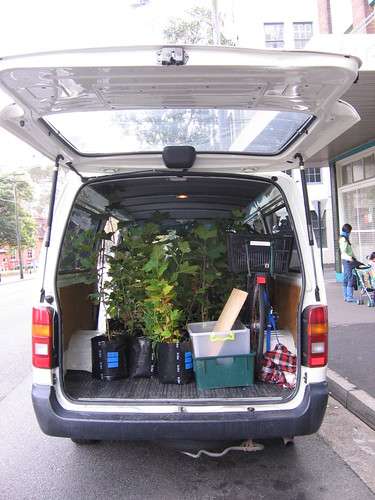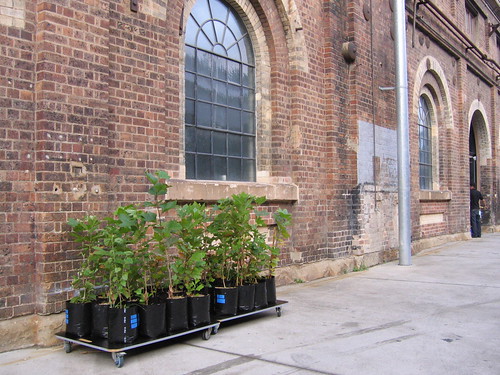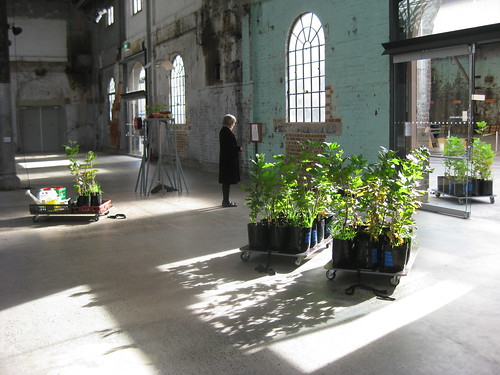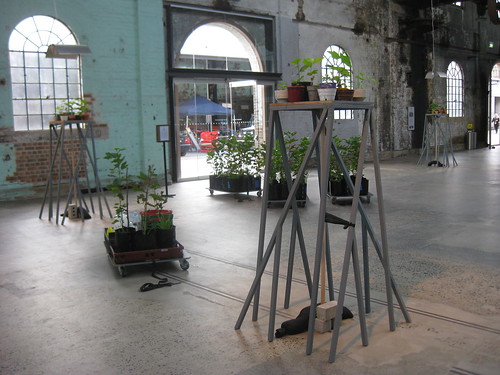 Â
Â
 Â
Â
 Â
Â
 Â
Â
 Â
Â

The Lively Plane (continued).
February 2008 – June 2009
growing and ongoing
and part of:
curated by Zanny Begg & Keg de Souza
The Performance Space
May-June 2009
Sydney
By June 2009 «The Lively Plane (continued)» will have played out along the leafy length of Wilson Street – plus inner-west & city sidelines – over two summers, two autumns, a winter and a spring. In February 2008 I used a commercially farmed London Plane tree (Platanus x acerifolia) in a work for the exhibition «1.The Lively Plane» at the Institute for Contemporary Art Newtown (ICAN) at 191 Wilson St.
Then and now, my interest is in the strong opinion and emotion that attends plane trees. They are both the most commonly planted street tree in Sydney, other Australian capitals and many world cities, and the most widely disliked for the profuse, fine, allergy-provoking bristles that aid seed dispersal from the flower-heads. They are the trees that everyone hates. While favoured for their tolerance of contemporary urban conditions – bad air, poor light, compacted soil and little water – their detractors are many, from talkback radio callers to prominent Australian scientist Tim Flannery. Flannery has often argued against the planting of London planes in Sydney streets, as both a persistent mimicry of European cities and a failure to explore alternatives from our ample native species that would better foster insect life and biodiversity, which plane trees notably do not.
In one of many conversations with passers-by at ICAN, I met a resident growing planes from the abundant seed distributed by local street trees. I guerrilla planted the ICAN plane onto the nearby Eveleigh Carriage Workshops site, but it died in the spring. At the same time I began propagating from the ready surplus of seed lying in the streets for «2. Field Work». «The Lively Plane (continued)» has become a mesh of daily practices including cultivation, observation, reading, problem-solving, mistake-making and consultation – bridging the sites of the street, studio, home garden and public gallery. A learning-by-doing exercise in amateur horticulture, the potential disruption to the regulated management of street trees by city councils points to the minimised influence of individuals in planting public space. Likewise the significance of ‘leafy streets’ to neighbourhood desirability and nature’s entanglement in the mechanics of gentrification becomes another resonant thread.
The project culminates as part-installation, part-potting shed for offspring of Wilson Street’s own avenue of planes within «There Goes the Neighbourhood» – engaging inside and out of the CarriageWorks site (229-245 Wilson St) and the material language of street and tree management in the wider field of Eveleigh and Redfern. Lastly the trees will be dispersed in a gifting gesture appropriating the green-conscious council plant giveaway, handing the future planting and flourishing of these trees over to others.
LK
summer 09.
postscript.
While thick drifts of fallen Plane tree leaves line the local streets, autumn was inadvertently held at bay for these trees by a street light over the building awning where they’d been positioned since late summer. The distortion of the seasons continues via the strong grow lighting that the seedlings will bask in by night at CarriageWorks. As «There Goes the Neighbourhood» approached, I found I’d lost a decisive way of telling people about my project – the simple task of sustaining these trees had become so ingrained in my daily movements, I’d drifted from a clear sense of ‘why’. This presentation represents one moment of many in the lifespan of these trees, more observational than oppositional, through which I might further decipher the meaning of these things in the streets in conversation with others.
LK
autumn 09
materials.
London Plane trees and seedlings grown from seed of Wilson St and local street trees, potting mix, compost, worm castings, mulch, plastics, grow lighting, replica steel tree guards unique to Eveleigh St Redfern designed and installed by the Maintenance department of former South Sydney Council, epoxy primer, dowel, tree wrap, hessian, sand, gravel and cement bricks found on Eveleigh Railway Workshops site, form ply, castors, nylon strap, hardware, plastics, water, sign board, printed text, A0 photocopy, paste.
steel fabrication by Terry Roy
notes.
* A poster on the Wilson St fence line marks the site of the first guerrilla planted Plane.
* The trees will be free to take at the close of the exhibition. If you are interested to plant one or some, please contact me at lkell88 [at] gmail [dot] com or come along on Saturday, 27th June 2009.
reading and reference.

‘The Plane Tree, due to its robust structure and resistance to urban conditions, is particularly suited for planting in the City’s harsh urban environments. Its deciduous nature allows for winter sun and summer shade. Plane trees also have a noted tolerance to pollution and their broad leaves take many airborne particulate pollutants out of City air.’
– City of Sydney Council on Plane Trees.

City of Sydney Street Tree management policy and Master Plan.

‘I used to joke that I’d shout beer all round at my local pub the day someone brought me a plane tree leaf that an insect had actually taken a bite out of. The fact is, that as far as Australian wildlife goes, plane trees are so useless that they might as well be made of concrete.’
– Tim Flannery can buy me a beer.

General Information
Scientific name: Platanus x acerifolia
Pronunciation: PLAT-uh-nus x ass-er-ih-FOLE-ee-uh
Common name(s): London Plane Tree
Family: Platanaceae
Invasive potential: little invasive potential
Uses: specimen; street without sidewalk; shade; parking lot island > 200 sq ft; sidewalk cutout (tree pit); tree lawn > 6 ft wide; urban tolerant; highway median.
– The Institute of Food and Agricultural Sciences (IFAS) fact sheet, University of Florida.
‘An ancient plane grove, for instance, was said to be built by Hercules as a place of worship for his father Zeus. These and other plane trees were revered (prayed to and protected by a guardian, “the chief among trees†[Pliny]), rich (ornamented with gold and watered with wine), famous (associated with Zeus’s abduction of Europa, among other colorful stories), and long-lived (some believed to have lived 1,300 years)—these trees of the rural past, we imagine, were happy. Wutong (Chinese parasol tree), the plane tree’s alleged remote relative (mostly likely unrelated), appeared in classical poetry as old as the Book of Songs, and was known to the Chinese in many images: the single wutong by the well, the first wutong leaf that falls at summer’s end, the broad wutong leaves on which the midnight rain falls. We also imagine these trees, revered by scholars as the only kind where the phoenix would stoop to repose, happy…
Supposing a tree’s affective faculty extend beyond its sensation, we can further imagine its unhappiness in its relationship with humans due to the latter’s confusion, oblivion, and indifference. No longer a significant feature of the landscape, a tree does not induce the feeling of home or exile, nor is it revered as a divine dwelling. Plane or parasol, modern trees feature in contemporary urban landscaping like bricks and cement for space organization…
Focusing on the cases of plane and parasol trees, this paper proposes to address the problem of happiness (or unhappiness) of a tree, and also of the human kind, in a postmodern urban setting: To what extent is an urban tree full or void of being? What competitions (with human beings and with other tree species) does a tree face to survive and propagate? To what extent and in what ways is human beings’ fullness of being dependent on a tree’s full being? What manipulation of the tree (the natural) is exercised by urban dwellers, and what does such manipulation reflect about the happiness or unhappiness of their lives in the postmodern era?’
– On the Happiness of a Tree…and of Men and Women
Dr. Chiu Chu Lee, Julie (Department of Translation, Lingnan University)
download pdf of full extract [52kb]
“I believe that planting these oaks is necessary not only in biospheric terms, that is to say, in the context of matter and ecology, but in that it will raise ecological consciousness-raise it increasingly, in the course of the years to come, because we shall never stop planting.
Thus, 7000 Oaks is a sculpture referring to peoples’ life, to their everyday work. That is my concept of art which I call the extended concept or art of the social sculpture.”
– Joseph Beuys
from 7000 Oaks, essay by Lynne Cooke with statements by Joseph Beuys.
Dia Art Foundation.
‘Dia installed five basalt stone columns, each paired with a tree, at 548 West 22nd Street in 1988, continuing the sculpture project 7000 Eichen (7000 Oaks) by German artist Joseph Beuys. Five different varieties of trees were planted: gingko, linden, bradford pear, sycamore, and oak. In 1996 Dia extended this project by planting 18 new trees, each paired with a basalt stone, on 22nd Street from 10th to 11th avenues, adding Pin Oak, Red Oak, Elm Honey Locust, Gingko and Linden.
Beuys’s project 7000 Oaks was begun in 1982 at Documenta 7, the large international art exhibition in Kassel, Germany. His plan called for the planting of seven thousand trees, each paired with a columnar basalt stone approximately four feet high above ground, throughout the greater city of Kassel. With major support from the Dia Art Foundation, the project was carried forward under the auspices of the Free International University (FIU) and took five years to complete, the last tree having been planted at the opening of Documenta 8 in 1987. Beuys intended the Kassel project to be the first stage in an ongoing scheme of tree planting to be extended throughout the world as part of a global mission to effect environmental and social change; locally, the action was a gesture towards urban renewal.’
– Dia Art Foundation long term project resources on 7000 Oaks by Joseph Beuys.
ARBORICULTURAL ASSESSMENT AND
DEVELOPMENT IMPACT REPORT FOR THE NORTH EVELEIGH SITE
Wilson St, Darlington
EXECUTIVE SUMMARY
‘Landscape Matrix Pty Ltd has been engaged by the Redfern-Waterloo Authority to prepare an Arboricultural report in respect to trees on or adjacent to the North Eveleigh site at Wilson Street, Darlington. The report is prepared to satisfy the Director-General’s Requirements issued in accordance with Section 75F of the Environmental Planning and Assessment Act 1979 for the Concept Plan for North Eveleigh.
The report identifies those trees that will require removal in the Concept Plan for the redevelopment of the site for a mix of uses including commercial buildings, residential apartments, community facilities and open space. The report also identifies trees that may be potentially affected by the proposed development, and makes recommendations with regard to other trees based on their species and condition.
The site has been developed and used for railway workshops for many decades in the past and the site has been cleared of its original vegetation for a long period of time. Some replanting of exotic and Australian plants has occurred over time in parts of the site. Many of the plantings are in declining health and very few of the trees within the site are of high landscape significance. A total 141 trees are located on the site, with an additional 82 trees located on Wilson Street, adjacent to the site.
The most significant vegetation on the site occurs at the eastern end in the vicinity of the Chief Mechanical Engineer’s Office building. These significant trees will be retained.’
– prepared by Landscape Matrix Pty Ltd, March 2008.
download pdf of full report [776kb]
street notes.









Eveleigh, Petersham, Chippendale, Redfern, Darlington, Surry Hills.
Sydney
statistics.
sep 08 : seeds planted – 100
oct 08 : seeds germinated – 53
nov 08 : seedlings – 51
dec 08 : seedlings – 50
jan 09 : seedlings – 39
feb 09 : treelings – 39 / batch 2. seeds pre-germinated – 75
mar 09 : treelings– 39 / batch 2. seedlings – 55
apr 09 : treelings – 39 / batch 2. seedlings – 50
may 09: treelings – 39 / batch 2. seedlings – 44
Â
Â
for helping hands, skills, gear and know-how
thanks & acknowledgements to: Lucas Ihlein, Josie Cavallaro, Sarah Goffman, Bec Dean, Richard Manner, Garth Knight, Keg de Souza, Zanny Begg, Terry Roy, Rohan Stanley, Simon Barney, Anne Kay, Jakob Jakobsen, Karen Sweeney (City Arborist, City of Sydney), Simon Cavanough, Govinda Webster, Annandale Garden Centre, Peter Jackson, Jane Polkinghorne, Anne Kay, Anne Deslandes, Alex Gawronski, Carla Cescon, Dennis Tan.
Â
Â

read about the Artist Funded logo here
































